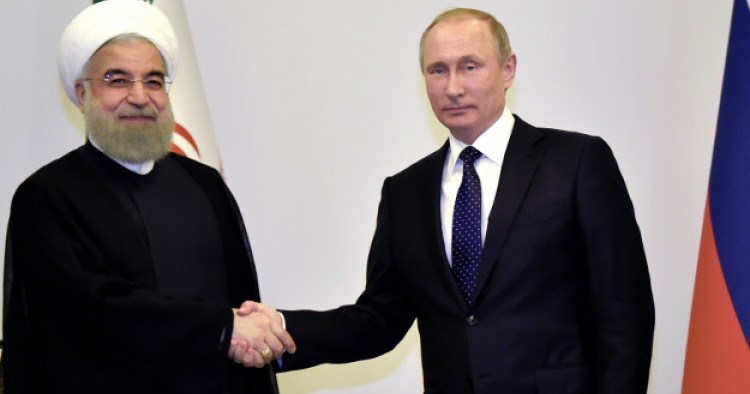A senior Iranian official has said that cooperation between Iran and Russia in Syria elevated relations between the two countries to a strategic level and changed the balance of power in Syria in favor of the government of Bashar al-Assad and its foreign allies. “The alliance between Iran, Russia, Syria, Iraq and the Lebanese Hezbollah succeeded to alter equations in Syria,” Ali Shamkhani, Secretary of Iran’s Supreme National Security Council said in an interview published today on the Islamic Republic News Agency. The influential Iranian official also noted that Russia and Iran have cultivated closer diplomatic, commercial and military ties after the removal of most nuclear-related sanctions on Iran in January 2016. He also expressed the hope that the Iranian-Russian cooperation in Syria would lead to the formation of a broader regional alliance.
“On the other hand, after strategic cooperation between Iran and Russia in Syria, political calculations have also changed. In the past, America and some Arab countries using money for lobbying were trying to question the legitimacy of the Syrian government. But today, in addition to the fact that the Syrian government’s status and authority are confirmed, the Astana talks are spearheading the most important part of the political process and negotiations,” added Shamkhani, who is also an advisor to Supreme Leader Ali Khamenei. He emphasized, though, that Iran’s close ties with Russia would never violate Iran’s policy of “independence and non-reliance on world powers,” but pursue “common purposes.”
Comment: Relations between Iran and Russia have significantly improved in the past two years. The two countries have been coordinating closely in the Syrian war and are boosting defense ties. Since the lifting of nuclear-related international sanctions on Iran in January 2016, Iran has received advanced weapons from Russia, including the long-delayed S-300 missile defense system. Moscow and Tehran are also negotiating the supply of around $10 billion worth of arms and military hardware to Iran. The deal reportedly includes T-90 tanks, artillery, planes and helicopters.
The Trump administration’s more assertive military role in the Syrian conflict – particularly the U.S. retaliatory strikes in Syria in April – appears to have brought Tehran and Moscow even closer. But that may change in the long term as their vital interests and endgame strategy in Syria are not the same.
The two countries are also seeking to expand non-military ties. Iranian President Hassan Rouhani met with his Russian counterpart Vladimir Putin on March 28 in Moscow to “examine the full spectrum of bilateral cooperation, with particular focus on expanding trade, economic and investment ties, including in the context of carrying out big joint energy and transport infrastructure projects.”
But despite frequent bilateral meetings and cooperation in Syria, economic and trade relations between the two countries are still lagging behind. Since the lifting of nuclear-related sanctions, the volume of trade between Russia and Iran, according to statistics provided by officials of the two countries, has increased by about 80 percent. But the aggregate trade turnover was still a meager $2 billion in 2016, and Iran does not rank in Russia’s top 15 trading partners. While both Moscow and Tehran have pledged to boost bilateral trade to $10 billion in the next two or three years, the realization of it depends on several factors – particularly the two countries’ relations with the Trump administration. If the Trump administration, for example, decides to put additional sanctions on Iran or even implement the existing unilateral American sanctions on the country more vigorously, many Russian energy giants and arms manufactures will be reluctant to invest in and do business with Iran. A potential U.S. designation of the Islamic Revolution Guards Corps (I.R.G.C.) as a “Foreign Terrorist Organization” will also complicate Iran-Russia trade ambitions. This is because the I.R.G.C. and its front companies dominate the Iranian economy and industrial sector, and it is almost impossible to do business with Iran without the I.R.G.C.’s involvement in some capacity.
Even in Syria, Iranian and Russian long-term objectives are not aligned. While Russia and Iran have been cooperating closely in the Syrian conflict, their vital interests and endgame strategy in Syria are different. Now that the regime of Bashar al-Assad is in control of key urban population centers, Russia is apparently seeking to reduce its military role and find a political solution to end the conflict in Syria as long as its strategic interests are secured. Iran, however, still favors a military victory and seeks to consolidate the presence of its proxies there for its broader regional agenda – both against Israel and regional rivals such as Turkey and Saudi Arabia. Iran has shown in recent months that it is both able and willing to undermine any Russia-led or U.N.-sponsored peace efforts through its regional proxies.
Rhetoric aside, the relationship between Russia and Iran remains more a marriage of convenience than a strategic alliance. A history of distrust and divergence of interests continue to hinder the two countries’ tactical cooperation from translating into a strategic relationship. Iranian media often questions Moscow’s sincerity. When officials of the two countries announced the start of their negotiation over the arms deal, a number of Iranian parliamentarians, analysts and media outlets expressed doubt – citing that Moscow delayed the delivery of S-300 missiles for many years and sided with world powers to sanction Iran.
The Middle East Institute (MEI) is an independent, non-partisan, non-for-profit, educational organization. It does not engage in advocacy and its scholars’ opinions are their own. MEI welcomes financial donations, but retains sole editorial control over its work and its publications reflect only the authors’ views. For a listing of MEI donors, please click here.













